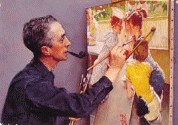Hoping for the Unexpected

I am in the midst of a seven day road trip, so have dipped into our files for a column I had written previously. By next week I’ll have a fresh adventure to share!
Washington has never claimed to be the birthplace of the Arts & Crafts movement, nor did the Arts & Crafts movement ever play a pivotal role in the development of our capital city, a city dominated by stately statues and seemingly supported by an even larger number of fluted, marble and limestone columns.
But if I have learned anything as an Arts & Crafts collector, it is this: “Look closely and you will find it.”
Our trip to Washington last week, however, was not intended to be a scouting expedition for our Traveler’s Guide. It was move-in weekend at Georgetown for my youngest son and so we arrived on Friday evening with our car packed to the roof and a bicycle dangling from a borrowed carrier strapped to the rear hatch door.
We knew we would have Friday to ourselves as Blake and I drove for eight hours from Asheville through the scenic Virginia corridor nestled amid the Appalachian Mountains, concluding with a relaxing stroll around the campus that evening and dinner at The Tombs.
Saturday was museum day. His first choice was the Newseum, which turned out to be even more remarkable, educational and entertaining than either of us had expected. We literally turned back pages in time, though I had a few more pages to turn than my 18-year-old son. It was in the far back corner of the lowest level that we stumbled across our first unexpected example of Arts & Crafts furniture: an early, pegged oak version of the electric chair. Tall, uncomfortable and virtually indestructible, it was undeniably Arts & Crafts, which explains why Gustav Stickley has been linked to the design of the first electric chair, but that’s a topic for next Monday’s column.
After a quick lunch it was my choice and I had known for several weeks what it would be. It was not, as Blake expected, anything Arts & Crafts. When I announced that I wanted to go over to the Smithsonian Museum of American Art to see the Norman Rockwell exhibit, I was stunned when he replied, “Who’s that?”
Now while my son is a pre-med student, I consider him well schooled in the fine arts, as well as Arts & Crafts (for that he was home schooled). That morning he had spent several minutes on-line, registering us for a lottery for tickets to see Twelfth Night. He won and that evening we watched the cast of the Shakespeare Theatre Company in the most enjoyable performance of any stage comedy I have ever seen.
But for him not to know who Norman Rockwell was seemed impossible to his Baby Boomer father, whose introduction to the American short story had come each week in the form of the Saturday Evening Post, for whom Norman Rockwell painted 322 covers between the years 1916 through 1963. Intrigued, perhaps, by his father’s intense explanation of who Norman Rockwell was and his attempt to capture an idealized view of ordinary events in American middle class life, he willingly accompanied me through the exhibit.
(In truth, he was more impressed that this particular exhibit had come from the collections of Steven Spielberg and George Lucas. If Spielberg and Lucas collected Norman Rockwell, he reasoned, it must be important.)
And it was.
Even if there wasn’t anything obviously Arts & Crafts in the scenes Rockwell immortalized on canvas.
The exhibition included a short film featuring both Steven Spielberg and George Lucas, as the two writers and directors explained what Norman Rockwell had meant to them growing up and why as adults they had each started collecting his work. Spielberg’s interview had been filmed in a studio, but George Lucas had given his interview in his home.
And there, next to George Lucas, was our second unexpected Arts & Crafts discovery: a Gustav Stickley table.
I nudged Blake and nodded toward the lower left corner of the enormous screen. He squinted, found the table, then rolled his eyes as if to say, “Can’t you ever just leave it at home?”
Apparently not.

Until next Monday,
Bruce
“Nothing of importance was ever achieved without enthusiasm.”
